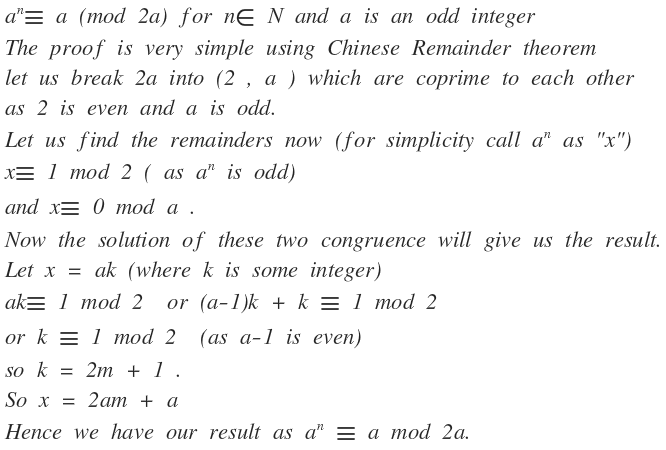Number Theory Observation
I was doing some number theory problems and while working on a problem I came up with an useful generalization.
I know it is not very special but it's worth sharing in my view.

No vote yet
1 vote
Easy Math Editor
This discussion board is a place to discuss our Daily Challenges and the math and science related to those challenges. Explanations are more than just a solution — they should explain the steps and thinking strategies that you used to obtain the solution. Comments should further the discussion of math and science.
When posting on Brilliant:
*italics*or_italics_**bold**or__bold__paragraph 1
paragraph 2
[example link](https://brilliant.org)> This is a quote# I indented these lines # 4 spaces, and now they show # up as a code block. print "hello world"\(...\)or\[...\]to ensure proper formatting.2 \times 32^{34}a_{i-1}\frac{2}{3}\sqrt{2}\sum_{i=1}^3\sin \theta\boxed{123}Comments
Nice result! However, I think you can greatly improve your writing and formatting; it seems very hard to read and follow, but I would probably chalk that down to your possible lack of experience with mathematical writing.
Log in to reply
I know but I cannot figure out how to use Latex .(I have absolutely 0 coding experience as I had never taken up computer science.) I try to use it but the writing gets all messed up. Maybe someone will type it out on Latex.
Log in to reply
I'm not just talking about LaTeX (I can understand that you may not know how to use it); I found the wording of the proof quite hard to follow. For example, instead of saying lines 2 to 7, you could say the following:
"As 2 and a are coprime, we would like to find x≡an (here, the "≡" sign means "defined to be") such that
x=1(mod 2)
and
x=0(mod a).
We note that this solution is unique by the Chinese Remainder Theorem."
If you were using LaTeX, you'd also want to take advantage of the Theorem/Proof layout, but even if you don't you would need to separate the theorem from the result. The subsequent six lines could also be rewritten in a similar flavour.
Log in to reply
Okay understood. I will try to better it ................You know after we've kicked our asses in cricket :)
Log in to reply
I hate the Aussie cricket team. National disgraces.
Log in to reply
I prefer rugby myself. I am a huge fan of Dave Pocock and Ben Foley
Somewhat more directly, it just boils down to a2≡a(mod2a). This follows since a(a−1)≡0(mod2a) as the first term is a multiple of a and the second term is a multiple of 2.